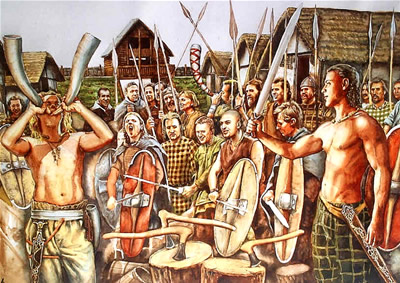 |
| Celts |
The Celts were a tribal people of the Bronze and Iron Ages united by a common language, culture, and art. They lived throughout Europe. Most were eventually conquered by the Romans and became a part of the Roman Empire.
Many unconquered areas have retained their separate language and culture for centuries. Ireland and parts of France, England, Wales, and Scotland can claim to be largely Celtic to this day. Language studies indicate that the Celts were an Indo-European group, first identified in Switzerland and Germany.
The first written references to Celts come from the Greeks in 630–600 b.c.e., who describe the Keltoi as mining and trading silver from the Iberian Peninsula. The period of Celtic history from the fifth through the first century b.c.e. is called La Tène, after a village on Lake Neuchâtel in Switzerland, where ancient pilings leading into the lake prompted excavations in the mid-19th century.
  |
Swords, shields, pins, razors, cauldrons, and even human remains were found buried in the silt of the lake, and many artifacts were decorated with graceful curving lines, whimsical faces, and plant motifs. The La Tène art style, since found in graves and monuments throughout the Celtic world, displayed the creativity and technical sophistication of the Celts.
Before and during the La Tène period, Celts had migrated, tribe by tribe, throughout Europe. By the seventh century b.c.e. they moved south through the Alps and into the Po Valley of Italy, where the Boii, Insubres, and Senones tribes of Celts attacked Etruscan cities.
Romans intervened as the Celts continued south but were defeated at the Battle of Allia in 390 b.c.e., after which the Senones, under the command of Brennus, sacked Rome and occupied the city for seven months. At that point Brennus accepted a bribe of 100 pounds of gold to leave, though Celtic forces harried the city for the next 50 years.
Other Celtic tribes lived in the Russian steppes by the mid-fourth century b.c.e. and were well established on the Balkan borders of Alexander the Great’s empire. They conquered Thrace and set up a Celtic dynasty to rule there through most of the third century b.c.e. This century marked the height of Celtic power and dominion.
The Celts had no empire, but independent tribes, some with populations in the hundreds of thousands, controlled much of Europe from the far west to the Black Sea. To the west the miners and artisans of Britain, Ireland, Spain, and Brittany traded in metals for centuries before being identified as Celtic.
The tribal names that were eventually used to identify them during the La Tène period (for instance, the Iceni and Veneti) do not reveal whether the people were indigenous or conquered indigenous groups or mixed with them. It is possible that these populations of these places considered themselves Celtic throughout the first millennium b.c.e.
Their enemies’ writings describe bloodthirsty savages whose cruelty knew no bounds. However, Celtic tribes could not have existed for centuries in their lands if they did nothing but wage war.
Graves and offering pits with spectacular weaponry point to a war-like people, but archaeologists find evidence of family homesteads with marked fields with grazing land. Like most Iron Age people, the Celts worshipped and sacrificed to a myriad of gods, many local and unique.
Their learned class—the Druids—were masters of astronomy, mathematics, philosophy, medicine, and history; they scorned writing and put their faith in training the memory.
Celtic women had more options and independence than women in Greece or Rome; writers such as Diodorus, Siculus, and Tacitus describe women who fought as warriors or served as tribal rulers.
Celtic warriors were renowned for being terrifying, functioning as independent fighters, and seeking to enhance personal reputations for heroics and glory. Many of these fighters would prove their skills by forgoing the lightest of Celtic armor and shields.
Opposing armies would often be faced with the frightening psychological warfare of fierce, crazed, unclothed long-haired barbarians. They were also known for a frightening habit of collecting heads.
Roman armies conquered the Celts or Gauls of northern Italy, warring from 225 b.c.e. through 190 b.c.e. The Dacians defeated the Celts of Bohemia in 60 b.c.e. Julius Caesar took western Iberia and then chronicled his conquests of the Celts or Gauls in The Gallic Wars.
His siege of Alesia in the Auvergne region, capturing tribal king Vercingetorix, completed his victories in 52 b.c.e. In the reign of Claudius, in 43 c.e., much of Britain was conquered.
The Celtic queen Boudicca led a major, but unsuccessful, revolt in 61 c.e. After earlier wars with Rome and Pontus, Celtic Galatia was absorbed into Cappadocia in 74 c.e. and a process of Romanization in Gaul occurred as in other Celtic lands.
Ireland was not conquered and remained independent and Celtic for centuries. It later adopted Christianity and writing. The few Irish books that have survived provide an account of ancient myths, poems, legal codes, and cultural practices of the Celts.